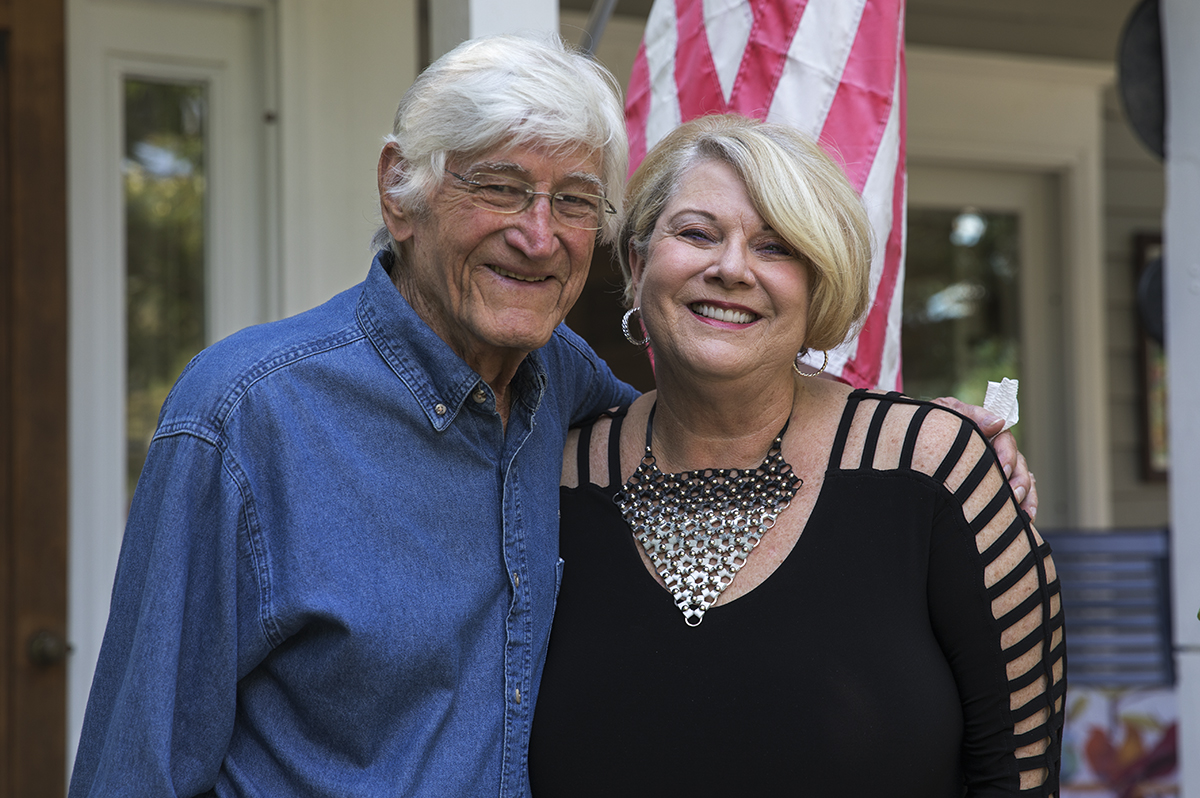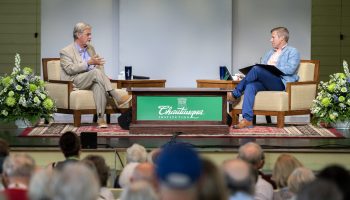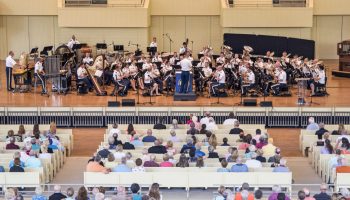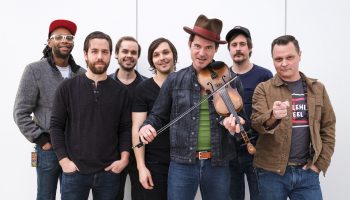Cathy Bonner is now in her 22nd year at Chautauqua Institution and just finishing her second year as chair of Chautauqua Foundation’s Board of Directors. A self-styled “serial entrepreneur” from Texas, Bonner helped lead the way to a critical intervention that pushed the Institution’s ambitious plan for a new Amphitheater over the finish line to completion.
Comfortably seated on her porch in central Chautauqua with her husband, Ken Wendler, a retired construction executive, we talked about her Chautauqua experience, the Foundation’s evolving role and visions for the Institution’s future.
How did your relationship with the Foundation evolve?
I think my Chautauqua story might be typical of many. I was actually spending time here for 10 years before I even knew there was a Foundation. It takes that long to figure out Chautauqua and to figure out your place in the community.
Once I began to feel established here, the Foundation helped me to add a philanthropic element to my story here. I think that this is one of the most vital roles the Foundation can play for Chautauquans. If you are thinking about your legacy here, the Foundation can help that feeling take shape in a comfortable way. I see the Foundation as kind of a toolkit to facilitate implementing your vision.
You’re from Texas. How and when did you get here originally?
A friend of mine from Austin, Texas, was planning to have her 50th birthday celebration here on the grounds in 1995. She had come to Chautauqua and brought her children for many years before. None of us friends of hers had ever heard of Chautauqua, except to hear her speaking about the place. A group of us rented a house down on Miller Park, spent the week, had the birthday party, and I guess we were hooked. Most of us have been back many times, and for me, it’s 22 straight years of returning here.
I think that part of my story may be typical, too. A lot of people get brought here by their friends, or perhaps family. For me, my first time here was magical. I began to come initially for a week or two. I began to think that if I planned my career right, I could have this place as my second home. That is basically what has happened.
Can you talk about your background in business and finance?
When I got here in 1995, I was in a real change mode. I had been what I call a serial entrepreneur for 20 years in my early career, primarily in the business of marketing and cable television and a few other things. I had left that career to go to work for my friend Ann Richards. She had been elected governor of Texas and appointed me as (director of the Texas Department of Commerce).
I felt I had the best job in state government at that time. I was in charge of economic development for the state, putting deals together, with mergers and acquisitions and corporate relocations. It was pretty heady stuff.
But in 1994, Ann was defeated for re-election by George W. Bush. I faced some decisions about my own future. I did know I wanted to go back to the private sector.
What I did was to rebuild a communications firm that specialized in what’s called 529 programs, which are programs for prepaid college tuition and college savings.
I worked with about a dozen states to build these programs. I did all the advertising. We started out with Texas, of course. That was a decade-long finance project. I loved it. In my previous life, I might have sold a real estate development here or assisted another state government with economic development there, but this 529 program was a product I could really believe in. This was helping parents save for their children’s college education. What could be more uplifting than that?
It was also during that time that I did a volunteer effort that ended up as fundraising. I had a recurring dream that by the turn of the century, we would have a national women’s history museum in the U.S. We had 2,000 museums in the U.S., and not one of them was dedicated to women’s issues. That project ended up taking four years, but we raised over $30 million and restored an older building in Dallas which is now the National Women’s History Museum.
I had been the foundation chair of the organization which took on that project. I kind of cut my teeth in fundraising on that project; during the time I was spending parts of my summers here at Chautauqua.
It’s easy to see the logic of you and the Foundation working together. But how did it come to pass?
I was invited. I didn’t really know much about the Foundation until I bought property here and began to stay here all summer long. Up to that point, I would just give to the Chautauqua Fund.
As my connection to Chautauqua was getting stronger, I took on a project involving a chain of auto collision repair centers in Texas. The owner wanted to grow the business rapidly, with a view to selling it eventually. He asked me to come in and manage the expansion. My background fit the project. I started with this in 2010 and we sold the business to private equity in 2012, and it was sold again in 2014. So at that point I had some philanthropic assets.
My background is really more business and finance than fundraising, but I did set up a fund to support a lectureship. Tom Becker got me involved in the Romeo & Juliet inter-arts project, and I became one of the sponsors. I was on the Foundation board by this time, and was beginning to understand how this place works in a financial sense. Now as chair of the Foundation board I am invited to attend meetings of the board of trustees, and I am an ex officio member of its Asset Policy Committee, which is central to the operation and future of the Institution.
The Foundation aggregates about $6 million each year that goes to the Institution’s bottom line. Some of that is endowment money, some of it is from the Chautauqua Fund and some comes from one-time program gifts. We have to do whatever it takes every year to meet our budgeted commitment — or exceed it! I came into the board chair position at the tail end of the tremendously successful Promise Campaign. A quarter of the $103 million raised over six years was Chautauqua Fund contributions.
Tell me about the Foundation’s role in financing the Amphitheater project.
I don’t think a lot of people realized the precarious nature of the old Amp. We all knew we had to make an investment that would carry Chautauqua for decades, if not centuries. I took over as Foundation board chair in August 2015, and at our October board meeting it was clear that cost of the Amphitheater still exceeded specified gifts for its renewal. As we have said over and over, all the money for the Amp had to be philanthropy.
From the Foundation point of view, we were invited to participate by the Institution in a way that never happened before. We were asked to join the Amp project, and the Foundation agreed to transfer an unrestricted gift it had received in the Promise Campaign to the project. We did so with the enthusiastic consent of the donor’s widow. And we set aside another $2.5 million of our unrestricted assets to cover the project’s contingency.
In addition, the Institution and the board of trustees invited us to be their banker for the project’s financing. You know, gifts for the Amp (and other purposes) come in over five years. Well, you have to pay the construction costs now. We had to get a line of credit and financing.
Did you have to collateralize the loan?
No. We didn’t have to offer collateral. We were able to do the financing without that. The Institution signed a loan agreement with us, and we signed one with the bank. The Foundation is absorbing the interest on the financing, so the Institution does not take any hit on that. We were very pleased to be a partner in helping get the Amp project over the finish line.
The board of trustees had some time ago instituted a checklist for any new or renovated building project. The first thing on that list is that all the money must come from philanthropy. You cannot use any of the asset base of the Institution to raise such funds.
The Institution and trustees sought a $5 million endowment for the new Amp. Where does that stand?
About $1 million has been raised. It is a hard sell because once a building is open and done, it’s hard to raise an endowment for it. A lot of people are at work seeking to raise the additional $4 million this summer. There are lots of places in and around the new Amp to commemorate donors. Generally, you need to raise an endowment in the first year if at all possible. We’ll get there.
Let’s talk about Bellinger Hall. That was the major unfunded project in the Promise Campaign. Some have said it is not a sexy enough project to attract the kind of major philanthropic gift that will be needed to complete its renovation, which might now cost $7 million or more.
I think there is some truth in that. I think people don’t know or think that much about Bellinger because the people affected are mostly students from the Institution’s summer arts programs. Dance students, opera students, music students. These are people who are living in a dormitory setting while they are learning. I don’t think too many people realize how important the performing arts students are to this Institution. And most of these students are not kids. They are in their 20s. You put them in an aging facility with subpar food, and it could ruin their experience here.
Not many people think of Chautauqua and think ‘Hey, I want to fund a student project.’ But when you really dig into what we do here, one of our most important activities is running exactly the programs whose participants live in Bellinger Hall.
Think about it: These young artists and performers go on from here with the background and knowledge they got in Chautauqua, and they can spread the word about us and enhance our standing and reputation in the arts.
I think we really need to think about how to get Bellinger done before any new capital campaign starts. Bellinger is a dorm, basically, but it could possibly become an art student complex. There are needs in the dance and theater programs, for example, that could be met with a reimagining of Bellinger.
President (Michael E.) Hill talks about more off-season programs on the grounds and a greater region-wide focus. Isn’t Bellinger well suited to host such activities?
Absolutely. I could imagine a small regional theater company based in a revived Bellinger Hall. I love that the Institution has gotten involved in the off-season children’s (playwright program). Michael Hill has put a high priority on regionalizing the off-season, and I support that enthusiastically. I think Bellinger stays student-driven in the season and regional-driven in the off-season. There are lots of possibilities.
What about the Athenaeum Hotel?
The hotel needs attention, too. You know, the hotel is really basically the only place people can stay for less than a week. The hotel is making money now, and that’s without a full renovation. The hotel can be both a revenue producer for the Institution and help to fill the major shortfall in accommodations we seem to continually face on the grounds. I think some of the packages they offer now are really good deals. And the hotel clearly fills housing needs for many of our visitors.
It’s been well documented that if visitors don’t have a good accommodation experience and can’t find good places to eat, that’s a key reason they don’t return.
With the Foundation entering a partnership with the Institution on finishing the Amp project, are we entering a new period between the organizations?
I do think it’s a new day. The Foundation’s endowment and the Institution were set up as separate entities 75 years ago, probably to make sure no one on the board of trustees or in the Institution’s administration began to think about tapping the endowment in dire financial times. Now it’s a bigger Chautauqua. It’s their strategic plan. We on the Foundation have to find ways to finance it.
We have a new president and several new vice presidents and new staff and some new roles. Do you sense rejuvenation on the grounds?
Yes. It’s always important for new sets of eyes to look at issues and situations. We’re all very enthusiastic about our new president’s vision and approach. From a Foundation point of view, there’s no question that he understands the absolute need to raise funds to sustain this special place. Four Foundation board members were on the presidential search committee, so we certainly had input. Without a solid financial base, so much of what Chautauqua does is suddenly in question.





